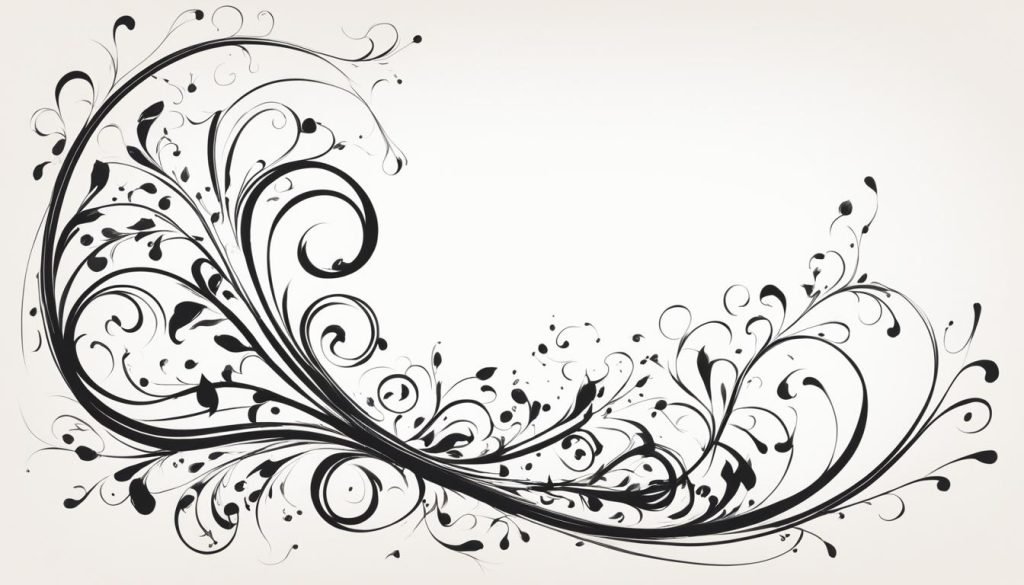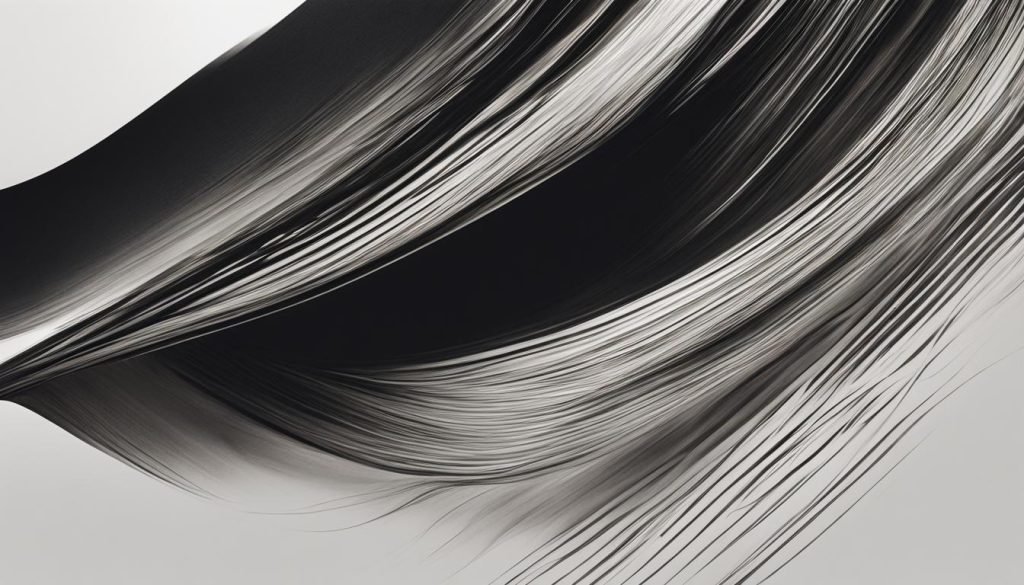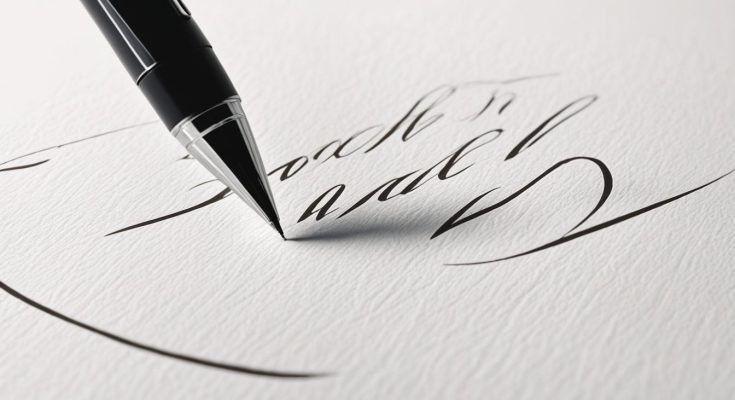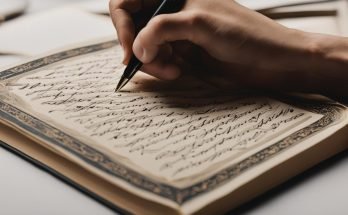Calligraphy Practice for Legibility: Unlock the Secrets to Clear and Beautiful Writing
Welcome to our guide on improving the legibility of your calligraphy! Calligraphy is an art form that involves creating beautiful, stylized letters. However, it’s essential to ensure that your calligraphy is legible and clear. In this section, we will share tips and techniques to help you enhance the legibility of your calligraphy and create stunning, readable pieces.
Key Takeaways:
- Practicing with a nice pen that suits you can greatly improve calligraphy practice for legibility.
- A relaxed grip on the pen allows for smoother and more precise letterforms.
- Handwriting drills and exercises can help enhance clarity and build confidence in your calligraphy.
- Experimenting with different paper rotations can help find the optimal angle for writing.
- Using worksheets and templates can provide structured practice to refine your letterforms.
Adding Flourishes to Your Calligraphy: Enhancing Elegance and Style

Calligraphy flourishes are the perfect way to elevate your writing and add a touch of elegance and individual style. These decorative and elaborate twists and curls can range from simple curves and loops to more complex designs where curves cross over each other. Regardless of whether you prefer modern or traditional calligraphy styles, incorporating flourishes can instantly enhance the overall aesthetic of your work.
While it may seem that flourishes are created spontaneously, they actually require meticulous craftsmanship. By mastering the art of adding flourishes to your calligraphy, you can take your writing to the next level and create truly breathtaking pieces.
When getting started with calligraphy flourishes, it’s best to begin practicing with a monoline pen or pencil. This allows you to develop control and familiarity with the shapes before moving on to more intricate tools. As you practice, focus on creating ovals as the foundation for your flourishes. Aim for 90-degree angles when lines intersect and be mindful of avoiding the crossing of two thick lines.
Experimenting with different sizes is also key to finding the flourish style that works best for you. Some calligraphers prefer smaller, delicate flourishes, while others opt for larger, more extravagant designs. Find what resonates with your personal style and practice incorporating these flourishes into your calligraphy.
To give you some inspiration, here are a few popular flourish styles in calligraphy:
- Cascading Flourishes – These elegant flourishes cascade down the page, adding a sense of movement and grace to your writing.
- Vine Flourishes – Resembling delicate vines, these flourishes twist and turn, creating an organic and natural aesthetic.
- Swash Flourishes – These bold and curvaceous flourishes extend from letters, adding a touch of drama and flair to your calligraphy.
Incorporating Flourishes: Techniques and Tips
Here are a few techniques and tips to help you incorporate flourishes into your calligraphy:
- Start simple: Begin with basic, easy-to-master flourishes and gradually work your way up to more complex designs.
- Practice with intention: Devote dedicated practice time to perfecting your flourishes. Focus on fluidity, consistency, and overall aesthetics.
- Find inspiration: Study the work of experienced calligraphers and explore various calligraphy styles to spark your creativity.
- Experiment with spacing: Play around with the placement and spacing of your flourishes to achieve visual balance and rhythm.
- Combine with letterforms: Integrate your flourishes with the letters themselves, creating a harmonious flow between the two.
Remember, adding flourishes to your calligraphy is all about expressing your unique style and enhancing the elegance of your writing. Embrace the artistry behind flourishes and let your creativity flourish.
| Benefits of Adding Flourishes to Calligraphy | Sample Flourish Techniques |
|---|---|
| Enhances elegance and style | Cascading Flourishes |
| Creates a sense of movement and grace | Vine Flourishes |
| Adds a touch of drama and flair | Swash Flourishes |
Beautiful Handwriting: The Art of Penmanship

Beautiful handwriting is an art form that can be developed and refined through practice and dedication. It goes beyond mere legibility and encompasses a sense of rhythm and flow, with consistent letter size, spacing, and slant. While everyone’s handwriting has personal touches and unique letterforms, there are basic techniques that can be honed to achieve better penmanship.
One of the key elements in developing nice handwriting is maintaining good posture and proper positioning of the hand and paper. Sitting up straight with your feet flat on the ground and the paper at a comfortable angle can greatly improve your writing. Additionally, controlling the pressure applied to the pen can help achieve a more smooth and controlled writing style.
Dedicated practice is also crucial in improving penmanship. Regular handwriting drills can help focus on specific aspects such as letter formation and spacing. By practicing these drills, you can develop muscle memory and refine your technique. Engaging in consistent handwriting practice, whether it’s writing in a journal or addressing envelopes, allows for continuous improvement.
It’s important to note that handwriting does not solely reflect intelligence. Rather, it speaks to an individual’s uniqueness and is influenced by factors such as hand-eye coordination and bone structure. Embrace your own style and aim for legibility and clarity while maintaining your personal touch.
| Techniques for Better Handwriting | Handwriting Tips |
|---|---|
|
|
Quote:
“Beautiful handwriting requires practice, patience, and a dedication to improving your penmanship. It’s an art form that allows your individuality to shine through.”
By incorporating these techniques and tips, you can develop beautiful handwriting that encapsulates both aesthetics and legibility. Remember, handwriting is a personal and unique expression of yourself, and with dedication and practice, you can create penmanship that is truly remarkable.
Examples of Beautiful Handwriting: A Feast for the Eyes
If you’re seeking inspiration to elevate your handwriting aesthetics, look no further than the penmanshipporn subreddit. This vibrant online community showcases a diverse array of stunning handwriting styles and captivating penmanship.
Beautiful handwriting captures attention through its neatness, tidiness, and legibility. Each individual’s handwriting is as unique as their personality, offering a window into their artistic expression. From calligraphy-inspired scripts to sleek and modern fonts, the examples found in penmanshipporn encompass a wide range of styles and aesthetics.
To cultivate beautiful handwriting, remember that practice makes perfect. By dedicating time to regularly refine your letter formation, spacing, and consistency, you can significantly enhance the aesthetics of your handwriting. Develop a rhythmic flow in your writing, paying attention to the placement and slant of each letter. Through practice and guidance, you can create visually pleasing penmanship that reflects your personal style.
It’s worth noting that beautiful handwriting does not require innate artistic talent or perfect pitch. Instead, it stems from deliberate practice and a commitment to improving your handwriting aesthetics. Embrace different handwriting styles as inspiration and experiment with variations that suit your preferences. Whether your goal is to achieve an elegant calligraphy-inspired script or to develop a unique handwriting style, regular practice and attention to detail will be instrumental in creating beautiful penmanship.
“Handwriting is a reflection of your unique personality and artistic flair.”
Remember, the aesthetics of your handwriting can impact how others perceive and interpret your written communication. Whether you’re jotting down personal notes, creating beautifully crafted invitations, or expressing your creativity through journaling, the beauty of your penmanship adds an extra layer of elegance and allure to your words.
Keep in mind that improving handwriting aesthetics is a journey that requires patience and persistence. Embrace the examples of beautiful handwriting you find inspiring, and let them serve as motivation on your quest to create handwriting that is truly a feast for the eyes.
A Sample of Exquisite Handwriting Styles
Below, we present a glimpse into the world of captivating and aesthetically pleasing penmanship. These examples showcase the diverse range of handwriting fonts and styles that can inspire your own journey towards beautiful handwriting.
| Handwriting Style | Description |
|---|---|
| Calligraphy-Inspired Elegance | A flowing script reminiscent of traditional calligraphy, characterized by graceful curves and elaborate flourishes. |
| Modern Minimalism | A sleek and minimalist style that focuses on clean lines, balanced spacing, and simplicity. |
| Vintage Charm | A nostalgic handwriting style that harks back to the bygone eras, featuring elegant loops and intricate details. |
| Whimsical Delight | A playful and imaginative style that embraces unique letterforms, quirky embellishments, and vibrant colors. |
| Architectural Precision | An architectural-inspired style that embodies precision, symmetry, and attention to detail. |
Explore these exquisite handwriting styles, and let them ignite your creativity as you embark on your own handwriting journey. Remember, your handwriting is an extension of your personality, and with dedication and practice, your handwriting can become a work of art that enchants and captivates.
Conclusion
Practicing calligraphy for legibility is key to achieving clear and beautiful writing. By implementing various techniques and tips such as using a high-quality pen, maintaining a relaxed grip, practicing handwriting drills, experimenting with paper angles, utilizing worksheets, incorporating extra practice, writing on lined paper or using templates, and embracing your personal handwriting style, you can enhance the legibility and clarity of your calligraphy.
In addition to practicing for legibility, adding flourishes to your calligraphy can elevate its elegance and individuality. By mastering the art of creating beautiful curves and loops, you can infuse your calligraphy with a unique touch that reflects your personal style and enhances its overall visual impact.
Remember, beautiful handwriting is a skill that can be developed through consistent practice and dedication. Pay attention to your posture, hand positioning, and the pressure you apply on the pen. Regular practice, focusing on letter formation, spacing, and maintaining consistency, will help you achieve improved penmanship aesthetics.
Examples of beautiful handwriting serve as inspiration, highlighting the various styles and individuality that can be achieved through penmanship. By honing your handwriting skills, you can create visually appealing written communication that not only conveys your message clearly but also leaves a lasting impression on the reader.
FAQ
What is the difference between calligraphy and handwriting?
Calligraphy is an art form that involves stylized, embellished letters, while handwriting refers to everyday writing. However, there is always room for improvement in handwriting.
How can I improve the legibility of my handwriting?
Here are some tips to improve legibility: use a nice pen that works well for you, maintain a relaxed grip on the pen, practice handwriting drills, experiment with paper rotations, use worksheets, incorporate extra practice, write on lined paper or use a template, and embrace your personal handwriting style while focusing on legibility and clarity.
What are calligraphy flourishes?
Calligraphy flourishes are decorative and elaborate twists and curls that add elegance and individual style to calligraphy. They can be simple curves and loops or more complex designs where curves cross over each other.
How can I incorporate flourishes into my calligraphy?
To incorporate flourishes into your calligraphy, start by practicing with a monoline pen or pencil to develop control and familiarity with the shapes. Focus on creating ovals as the foundation of your flourishes and aim for 90-degree angles when lines cross. Avoid crossing two thick lines and experiment with different sizes to find what works best for your style.
How can I develop beautiful handwriting?
Beautiful handwriting can be developed through practice and dedication. Focus on techniques such as letter formation, spacing, posture, proper hand and paper positioning, controlling pen pressure, and regular practice.
Where can I find examples of beautiful handwriting?
Examples of beautiful handwriting can be found in the penmanshipporn subreddit, showcasing a variety of styles and aesthetics. Handwriting that is neat, tidy, and legible with a pleasing rhythm and flow is considered beautiful and reflects the individual’s personality.




